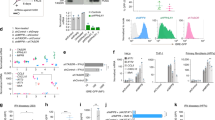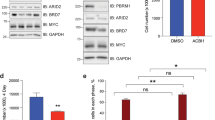Abstract
Brahma-related gene 1 (BRG1 ) is a key component of the ATP-dependent chromatin-remodelling SWI2–SNF2 complex and has been implicated in regulating gene expression, cell-cycle control and tumorigenesis. Here we report that BRG1 interacts with signal transducer and activator of transcription 2 (STAT2) — a transcription factor that regulates gene expression mediated by interferon-α (IFN-α). BRG1 enhances the IFN-α-induced expression of 9-27 and IFI27 but not that of four other target genes tested, showing that the activation of different target genes by STAT2 may involve alternative chromatin modifiers. Our results also suggest that the recruitment and activation of BRG1 may require other cis-acting and trans-acting elements in addition to STAT2. Our study links the SWI2–SNF2 complex to the regulation of cytokine-induced gene expression and may identify a molecular mechanism of BRG1-mediated gene activation and tumorigenesis.
This is a preview of subscription content, access via your institution
Access options
Subscribe to this journal
Receive 12 print issues and online access
$209.00 per year
only $17.42 per issue
Buy this article
- Purchase on SpringerLink
- Instant access to full article PDF
Prices may be subject to local taxes which are calculated during checkout








Similar content being viewed by others
References
Stark, G. R., Kerr, I. M., Williams, B. R. G., Silverman, R. H. & Schreiber, R. D. How cells respond to interferons. Annu. Rev. Biochem. 67, 227–264 (1998).
Darnell J. E. Jr STATs & gene regulation. Science 277, 1630–1635 (1997).
Leonard, W. J. & O'Shea J. J. JAKs & STATs: biological implications. Annu. Rev. Immunol. 16, 293–322 (1998).
Ihle, J. N. The Stat family in cytokine signaling. Curr. Opin. Cell Biol. 13, 211–217 (2001).
Becker, S., Groner, B. & Muller, C. W. Three-dimensional structure of the Stat3β homodimer bound to DNA. Nature 394, 145–151 (1998).
Chen, X. et al. Crystal structure of a tyrosine phosphorylated STAT-1 dimer bound to DNA. Cell 93, 827–839 (1998).
Wen, Z., Zhong, Z. & Darnell, J. E. Jr Maximal activation of transcription by Stat1 and Stat3 requires both tyrosine and serine phosphorylation. Cell 82, 241–250 (1995).
Wen, Z. & Darnell, J. E. Jr Mapping of Stat3 serine phosphorylation to a single residue (727) and evidence that serine phosphorylation has no influence on DNA binding of Stat1 and Stat3. Nucleic Acids Res. 25, 2062–2067 (1997).
Park, C., Li, S., Cha, E & Schindler, C. Immune response in Stat2 knockout mice. Immunity 13, 795–804 (2000).
Khavari, P. A., Peterson, C. L., Tamkun, J. W., Mendel, D. B. & Crabtree, G. R. BRG1 contains a conserved domain of the SWI2/SNF2 family necessary for normal mitotic growth and transcription. Nature 366, 170–174 (1993).
Muchardt, C. & Yaniv, M. A human homologue of Saccharomyces cerevisiae SNF2/SWI2 and Drosophila brm genes potentiates transcriptionl activation by the glucocorticoid receptor. EMBO J. 12, 4279–4290 (1993).
Wang, W. et al. Purification and biochemical heterogeneity of the mammalian SWI–SNF complex. EMBO J. 15, 5370–5382 (1996).
Wang, W. et al. Diversity and specialization of mammalian SWI/SNF complexes. Genes Dev. 10, 2117–2130 (1996).
Kingston, R. E. & Narlikar, G. J. ATP-dependent remodeling and acetylation as regulators of chromatin fluidity. Genes Dev. 13, 2339–2352 (1999).
Vignali, M., Hassan, A. H., Neely, K. E. & Workman, J. L. ATP-dependent chromatin-remodeling complexes. Mol. Cell. Biol. 20, 1899–1910 (2000).
Reid, L. E. et al. A single DNA response element can confer inducibility by both α- and γ-interferons. Proc. Natl Acad. Sci. USA 86, 840–844 (1989).
Rasmussen, U. B. et al. Identification of a new interferon-α-inducible gene (p27) on human chromosome 14q32 and its expression in breast carcinoma. Cancer Res. 53, 4096–4104 (1993).
Tamkun, J. W. et al. Brahma: a regulator of Drosophila homeotic genes structurally related to the yeast transcription activator SNF2/SWI2. Cell 68, 561–572 (1992).
Kwon, H., Imbalzano, A. N., Khavari, P. A., Kingston, R. E. & Green, M. R. Nucleosome disruption and enhancement of activator binding by a human SWI/SNF complex. Nature 370, 477–481 (1994).
Fryer, C. J. & Archer, T. K. Chromatin remodeling by the glucocorticoid receptor requires the BRG1 complex. Nature 393, 88–91 (1998).
PHeLan, M. L., Sif, S., Narlikar, G. J. & Kingston, R. E. Reconstitution of a core chromatin remodeling complex from SWI/SNF subunits. Mol. Cell 3, 247–253 (1999).
Zhao, K. et al. Rapid and phosphoinositol-dependent binding of the SWI/SNF-like BAF complex to chromatin after T lymphocyte receptor signaling. Cell 95, 625–636 (1998).
Cote, J., Quinn, J., Workman, J. L. & Peterson, C. L. Stimulation of GAL4 derivative binding to nucleosomal DNA by the yeast SWI/SNF complex. Science 265, 53–60 (1994).
Hirschhorn, J. N., Brown, S. A., Clark, C. D. & Winston, F. Evidence that SNF2/SWI2 and SNF5 activate transcription in yeast by altering chromatin structure. Genes Dev. 6, 2288–2298 (1992).
Leung, S., Qureshi, S. A., Kerr, I. M., Darnell, J. E. Jr & Stark, G. R. Role of STAT2 in the α interferon signaling pathway. Mol. Cell. Biol. 15, 1312–1317 (1995).
Der, S. D., Zhou, A., Williams, B. G. & Silverman, R. H. Identification of genes differentially regulated by interferon α, β or γ using oligonucleotide arrays. Proc. Natl Acad. Sci. USA 95, 15623–15628 (1998).
Dunaief, J. L. et al. The retinoblastoma protein and BRG1 form a complex and cooperate to induce cell cycle arrest. Cell 79, 119–130 (1994).
Liu, R., Liu, H., Chen, X., Kirby, M., Brown, P. O. & Zhao, K. Regulation of CSF1 promoter by the SWI/SNF-like BAF complex. Cell 106, 309–318 (2001).
Ramana, C. V. et al. Regulation of c-Myc expression by IFNγ through Stat1-dependent and -independent pathways. EMBO J. 19, 263–272 (2000).
Ramana, C. V. et al. Stat1-independent regulation of gene expression in response to IFN-γ. Proc. Natl Acad. Sci. USA 98, 6674–6679 (2001).
Gil, M. P. et al. Biological consequence of Stat1-independent IFN signaling. Proc. Natl Acad. Sci. USA 98, 6680–6685 (2001).
Barker, N., Hurlstone, A., Musisi, H., Miles, A., Bienz, M. & Clevers, H. The chromatin remodelling factor Brg-1 interacts with β-catenin to promote target gene activation. EMBO J. 20, 4935–4943 (2001).
Bhattacharya, S. et al. Cooperation of Stat2 and p300/CBP in signaling induced by interferon-α. Nature 383, 344–347 (1996).
Chen, H., Tini, M. & Evans, R. M. HATs on and beyond chromatin. Curr. Opin. Cell Biol. 13, 218–224 (2001).
Farrants, A.O, Blomquist, P., Kwon, H. & Wrange, O. Glucocorticoid receptor-glucocorticoid response element binding stimulates nucleosome disruption by the SWI/SNF complex. Mol. Cell. Biol. 17, 895–905 (1997).
Direnzo, J. et al. BRG-1 is recruited to estrogen-responsive promoters and cooperates with factors involved in histone acetylation. Mol. Cell. Biol. 20, 7541–7549 (2000).
Bochar, D. A. et al. BRCA1 is associated with a human SWI/SNF-related complex: linking chromatin remodeling to breast cancer. Cell 102, 257–265 (2000).
Bultman, S. et al. A Brg1 null mutation in the mouse reveals functional differences among mammalian SWI/SNF complexes. Mol. Cell 6, 1287–1295 (2000).
Wong, A. K. C. et al. BRG1, a component of the SWI–SNF complex, is mutated in multiple human tumor cell lines. Cancer Res. 60, 6171–6177 (2000).
Versteege, I. et al. Truncating mutations of hSNF5/INI1 in aggressive paediatric cancer. Nature 394, 203–206 (1998).
Deblandre, G. A. et al. Expression cloning of an interferon-inducible 17-kDa membrane protein implicated in the control of cell growth. J. Biol. Chem. 270, 23860–23866 (1995).
Paulson, M., Press, C., Smith, E., Tanese, N. & Levy, D. E. IFN-stimulated transcription through a TBP-free acetyltransferase complex escapes viral shutoff. Nature Cell Biol. 4, 140–147 (2002).
Acknowledgements
We thank J. Darnell, G. Stark and I. Kerr for the STAT2 cDNA, 2fTGH, U6 and 293T cells; K. Zhao for SW-13 and C33A cells, BRG1 cDNA, antibodies against BRG1 and BAFs; B. Jiao and Y. Law for technical support; and S. Lin and D. Liu for critically reading the manuscript. This work was supported by the Agency for Science, Technology and Research (Z.W.).
Author information
Authors and Affiliations
Corresponding author
Ethics declarations
Competing interests
The authors declare no competing financial interests.
Supplementary information
Supplementary figures
Figure S1 Quantification of the Northern blot analysis of 9-27 and IFI27 gene. SW (PDF 27 kb)
Figure S2 -184 to -128bp region of 9-27 promoter is responsible for IFNα induction and BRG1-mediated activation.
Rights and permissions
About this article
Cite this article
Huang, M., Qian, F., Hu, Y. et al. Chromatin-remodelling factor BRG1 selectively activates a subset of interferon-α-inducible genes. Nat Cell Biol 4, 774–781 (2002). https://doi.org/10.1038/ncb855
Received:
Revised:
Accepted:
Published:
Issue Date:
DOI: https://doi.org/10.1038/ncb855



